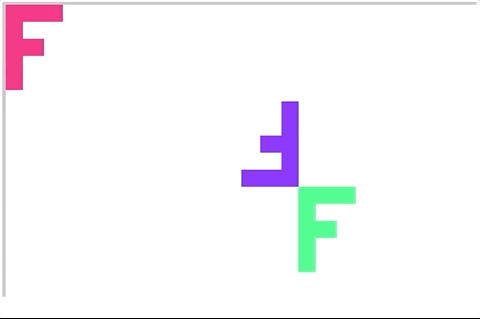How to implement zoom from mouse in 2D WebGL
Question:
I’m currently building a 2D drawing app in WebGL. I want to implement zoom to point under mouse cursor similar to example in here. But I can’t figure out how to apply the solution from that answer in my case.
I have done basic zoom by scaling camera matrix. But it zooms to the top-left corner of the canvas, due to that being the origin (0,0) set by the projection (as far as I understand).
Basic pan & zoom implemented:

My draw function (including matrix computations) looks like this:
var projection = null;
var view = null;
var viewProjection = null;
function draw(gl, camera, sceneTree){
// projection matrix
projection = new Float32Array(9);
mat3.projection(projection, gl.canvas.clientWidth, gl.canvas.clientHeight);
// camera matrix
view = new Float32Array(9);
mat3.fromTranslation(view, camera.translation);
mat3.rotate(view, view, toRadians(camera.rotation));
mat3.scale(view, view, camera.scale);
// view matrix
mat3.invert(view, view)
// VP matrix
viewProjection = new Float32Array(9);
mat3.multiply(viewProjection, projection, view);
// go through scene tree:
// - build final matrix for each object
// e.g: u_matrix = VP x Model (translate x rotate x scale)
// draw each object in scene tree
// ...
}
Vertex shader:
attribute vec2 a_position;
uniform mat3 u_matrix;
void main() {
gl_Position = vec4((u_matrix * vec3(a_position, 1)).xy, 0, 1);
}
Zoom function:
function screenToWorld(screenPos){
// normalized screen position
let nsp = [
2.0 * screenPos[0] / this.gl.canvas.width - 1,
- 2.0 * screenPos[1] / this.gl.canvas.height + 1
];
let inverseVP = new Float32Array(9);
mat3.invert(inverseVP, viewProjection);
let worldPos = [0, 0];
return vec2.transformMat3(worldPos, nsp, inverseVP);
}
var zoomRange = [0.01, 2];
canvas.addEventListener('wheel', (e) => {
let oldZoom = camera.scale[0];
let zoom = Math.min(Math.max(oldZoom + e.deltaX / 100, zoomRange[0]), zoomRange[1]);
camera.scale = [zoom, zoom];
let zoomPoint = screenToWorld([e.clientX, e.clientY]);
// totally breaks if enable this line
//vec2.copy(camera.translation, zoomPoint);
// call draw function again
draw();
}, false);
If I apply zoomPoint to camera translation, the values of zoomPoint (and the camera position accordingly) start to raise up uncontrollably with every zoom event (no mater if I zoom in or out) and the objects drawn in the scene go immediately out of view.
Would greatly appreciate any insights or suggestions about what am I doing wrong here. Thanks.
Answer:
Since you didn’t post a minimal reproducible example in the question itself I couldn’t test with your math library. Using my own though I was able to zoom like this
const [clipX, clipY] = getClipSpaceMousePosition(e);
// position before zooming
const [preZoomX, preZoomY] = m3.transformPoint(
m3.inverse(viewProjectionMat),
[clipX, clipY]);
// multiply the wheel movement by the current zoom level
// so we zoom less when zoomed in and more when zoomed out
const newZoom = camera.zoom * Math.pow(2, e.deltaY * -0.01);
camera.zoom = Math.max(0.02, Math.min(100, newZoom));
updateViewProjection();
// position after zooming
const [postZoomX, postZoomY] = m3.transformPoint(
m3.inverse(viewProjectionMat),
[clipX, clipY]);
// camera needs to be moved the difference of before and after
camera.x += preZoomX - postZoomX;
camera.y += preZoomY - postZoomY;
Note that zoom is the opposite of scale. If zoom = 2 then I want everything to appear 2x larger. To do that requires shrinking the camera space so we scale that space by 1 / zoom
Example:
note that I included camera.rotation just to make sure things worked if rotated. They seem to. Here’s one with zoom, pan, and rotate